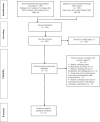The role of teledentistry in oral cancer patients during the COVID-19 pandemic: an integrative literature review
- PMID: 34219196
- PMCID: PMC8255116
- DOI: 10.1007/s00520-021-06398-0
The role of teledentistry in oral cancer patients during the COVID-19 pandemic: an integrative literature review
Abstract
Objectives: This integrative review aimed to assess the benefits of the use of teledentistry for patients undergoing treatment of oral and head and neck cancer during the COVID-19 pandemic.
Materials and methods: We searched in PubMed, Cochrane, Scopus, Web of Science, Lilacs, Embase, Open Grey, Google Scholar, and Jstor databases for studies referring to the management, control, and assistance, through teledentistry, to patients with oral and head and neck cancer during the COVID-19 pandemic.
Results: We found 356 references in the databases, 209 after duplicates removal, 23 met criteria for full-text reading, and 11 studies were included for qualitative synthesis, in four categories: virtual visits, use of remote technology, patient's satisfaction, multidisciplinary approach in teledentistry. We found that 78% of patients currently preferred teledentistry; 92% of patients would recommend the use of video consultation to other patients. The continuity of dental care, the reduction of patient visits to the hospital, the reduction of the risk of infection with the coronavirus, and limitation of face-to-face consultations to protect health professionals are benefits that reinforce the use of teledentistry by health institutions. Two studies showed patients' satisfaction with the use of teledentistry in monitoring cancer patients and showed an improvement in quality of life.
Conclusions: The teledentistry, as a remote technology for monitoring patients with oral and head and neck cancer, is well accepted by patients in preliminary studies. Although these studies pointed out some benefits of using remote technologies for the care of cancer patients, further robust scientific evidence is still needed in this regard.
Keywords: COVID-19; Head and neck cancer; Integrative review; Oral cancer; Teledentistry; Telemedicine.
© 2021. The Author(s), under exclusive licence to Springer-Verlag GmbH Germany, part of Springer Nature.
Conflict of interest statement
The authors declare no competing interests.
Figures
References
-
- WHO (2020) https://www.who.int/emergencies/diseases/novel-coronavirus-2019. Accessed on 10/11/2020.
Publication types
MeSH terms
LinkOut - more resources
Full Text Sources
Medical
Miscellaneous


